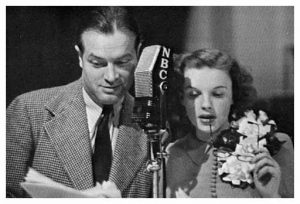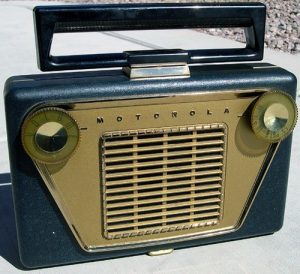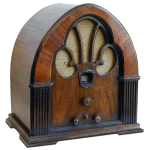CUYAHOGA FALLS BROADCAST MEDIA
OF THE 1950S AND 60S
AM RADIO STATIONS
AKRON
WADC 1350Khz CBS became WSLR in 1967
WAKR 1590 ABC Pop music
WHKK 640 MBS became WHLO in 1962
WHLO 640 “Hello Radio” Pop music
CLEVELAND
KYW 1100 NBC became WKYC in 1966
WABQ 1540
WDOK 1260 became WIXY in 1967
WERE 1300
WGAR 1220 CBS
WHK 1420 MBS “Color Radio”
WIXY 1260
WJMO 1540 became WABQ in 1964
WJW 850 ABC
WKYC 1100
CUY. FALLS
WCUE 1150 M.O.R. MUSIC
YOUNGSTOWN
WKBN 570
 Lots of the radios in use during the 50s were beautiful old wooden cased sets, and many people used big consoles from the 30s and 40s equipped with turntables for 78rpm records and shortwave receivers to hear the BBC and other wartime news from abroad. All of the radios used vacuum tubes that occasionally burned out and had to be replaced. You could save money by removing the tubes and testing them at the drugstore yourself rather than calling the repairman.
Lots of the radios in use during the 50s were beautiful old wooden cased sets, and many people used big consoles from the 30s and 40s equipped with turntables for 78rpm records and shortwave receivers to hear the BBC and other wartime news from abroad. All of the radios used vacuum tubes that occasionally burned out and had to be replaced. You could save money by removing the tubes and testing them at the drugstore yourself rather than calling the repairman.
AM Radio in this time period was still evolving and not yet overcrowded with local stations. Most stations operating with 1000 watts or less power were limited to daylight hours, leaving the night free for the 5000, 10,000 and 50,000 watt stations. Several regional powerhouse stations operated on exclusive frequencies and could be widely heard throughout the U.S. and Canada at night. In addition, the transmitters required periodic replacement and tuning of the final tubes, so testing at stations not normally on the air at night could often be heard, particularly on Sunday nights. This led to the popular hobby of DXing and kept lots of folks up with the insomniacs, especially in the summer when there was no school. Many of these regional stations were heard as strongly as the local stations after sunset (with some occasional ionospheric fading), and before the days of “corporate radio” offered unique air personalities and locally popular music. The list of all of these commonly heard in the Falls would be very long, but some of the favorites were:
CKLW Windsor, Ontario Rock music
KDKA Pittsburgh, PA The first commercial station in America
WABC New York Cousin Brucie playing rock n roll
WBZ Boston, MA Bruce Bradley was the night DJ
WCBS New York Long John Nebel and his Way Out World
WCFL Chicago Originator of Chicken Man “He’s Everywhere!”
WCKY Cincinnati Send in for your Big Hank Snow collection
WLS Chicago, IL featuring Dick Biondi, the world’s ugliest disc jockey
WLW Cincinnati ran a megawatt during WWII, was heard on stovepipes!
XERF Villa Acuna, Mex. UFOs and other strangeness
 Of course, the local stations also offered some interesting evening fare. In addition to the Lone Ranger, Amos n Andy and the other traditional shows, there were dance parties and some cool cats like: Casey at the Mike (WJW) with lots of sound bites “that was the sound of a man in pain”, etc., Jay Lawrence aka “The Jay Bird”(KYW) with his shaggy dog stories and Jerry G (Bishop) on KYW reporting the best spots for “counting alligators”. Daytimes were lightened by Specs (Howard) and Hare (Harry Martin, later Happy Hare) with the world’s corniest jokes on KYW. I’ve stayed current with Happy Hare and Jerry G, because they both wound up with me in San Diego, and up until August of 2004 they were still telling those bad jokes on KPQP. Unfortunately, the media moguls here have now replaced the music with Talk Radio, which seems to have become the fate of what was once a lively and entertaining medium. The early rock era was also filled with another kind of programming- the station jingles. Rock station WHK, in particular, couldn’t talk about anything without the aid of a snappy little tune in four part harmony:
Of course, the local stations also offered some interesting evening fare. In addition to the Lone Ranger, Amos n Andy and the other traditional shows, there were dance parties and some cool cats like: Casey at the Mike (WJW) with lots of sound bites “that was the sound of a man in pain”, etc., Jay Lawrence aka “The Jay Bird”(KYW) with his shaggy dog stories and Jerry G (Bishop) on KYW reporting the best spots for “counting alligators”. Daytimes were lightened by Specs (Howard) and Hare (Harry Martin, later Happy Hare) with the world’s corniest jokes on KYW. I’ve stayed current with Happy Hare and Jerry G, because they both wound up with me in San Diego, and up until August of 2004 they were still telling those bad jokes on KPQP. Unfortunately, the media moguls here have now replaced the music with Talk Radio, which seems to have become the fate of what was once a lively and entertaining medium. The early rock era was also filled with another kind of programming- the station jingles. Rock station WHK, in particular, couldn’t talk about anything without the aid of a snappy little tune in four part harmony:
Whether it’s cold
or whether it’s hot
were gonna have weather
whether or not
so before you go and play
here’s the weather for today!
SNOW
That was the weather,
now you know…..etc.
and always ending with the station logo- on WHK, color channel 14, color radio!
FM RADIO

Frequency Modulation was a brand new medium in the 1960s and the broadcasters weren’t quite sure what to do with it, so it was mostly used by colleges and universities who found it easier to get licensed there -WAPS, later WAUP at Akron University is a good example- and in classical or instrumental music formats. Some broadcasters simply mirrored their AM programs most of the day (WAKR-FM for example). Most of the music format stations had few if any commercials and there was little or no noise or interference, so businesses and housewives used it as background “elevator” music. This lasted only until inexpensive portable radios became available with the FM band, and by the 1970s the rush was on to move all music programs (and the advertising) onto FM. The FCC then mandated that FM stations be licensed separately and so all of the -FM call letters went away.
* This info was donated for the original CFH Website by anonymous.
Listen to old radio shows here or use this link: https://archive.org/details/oldtimeradio
Cuyahoga Falls Amateur Radio Club

